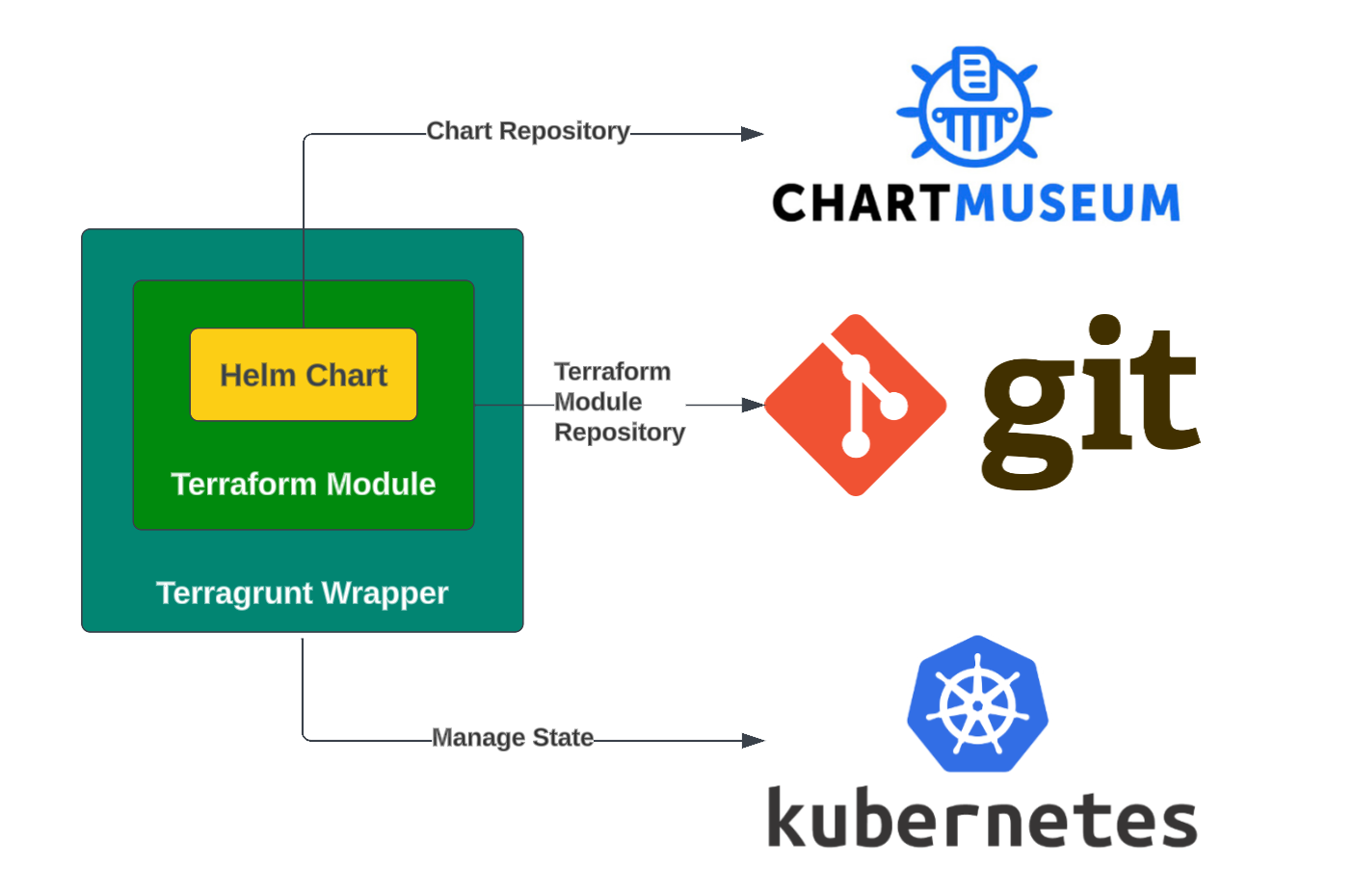Streamlining Kubernetes Deployments with Docker, Helm, Terraform, and Terragrunt

Maintaining a scalable, flexible, and easily deployable infrastructure is crucial. Kubernetes has emerged as a leading container orchestration platform, while Docker has become the de facto standard for containerization.
To manage and simplify the deployment process, many developers and DevOps engineers have turned to Helm for packaging applications, Terraform for infrastructure provisioning, and Terragrunt for orchestrating Terraform configurations.
In this blog post, we will explore how this powerful combination of tools enables a seamless and streamlined deployment workflow, and how you may be under-utilizing Terraform.
Key Components
Docker: Encapsulating Application Code for Portability
Docker containers have revolutionized software development by encapsulating applications, libraries, and dependencies in a consistent and portable environment. With Docker, you can package your project's application code and all its dependencies into a single, lightweight image. This image can be easily shared, version-controlled, and deployed across different environments without worrying about variations in the underlying infrastructure. (excluding platform arch considerations)
By leveraging Docker images, we can reduce the infamous "it works on my machine" problem. This consistency is especially valuable when deploying applications to Kubernetes clusters, as it eliminates the need to deal with subtle environment differences that could lead to production issues.
Helm Charts: Simplified Kubernetes Deployments
Kubernetes offers a robust and scalable platform for managing containerized applications, but its YAML manifests can be verbose and complex.
Helm, essentially a package manager for Kubernetes, simplifies the deployment process by providing a templating engine and a collection of pre-configured packages called "charts." These charts define the resources needed to run an application in Kubernetes, including deployments, services, and configuration files.
With Helm charts, developers can easily define, version, and manage complex Kubernetes deployments as code. The templating engine allows for parameterization, enabling the reuse of chart configurations with different values for each environment (e.g., development, staging, production). This abstraction helps standardize the deployment process and reduces the chances of human errors when deploying complex applications.
Q: How do we manage dependencies across charts? What kind of manual steps are there when the charts depend on externally created or attached resources?
Terraform: Declarative Kubernetes Configurations
While Docker and Helm handle application packaging and Kubernetes deployments, managing the underlying infrastructure can be challenging. Terraform, an Infrastructure as Code (IaC) tool, bridges this gap by providing a declarative way to define, provision, and manage infrastructure resources.
With Terraform's Kubernetes provider, developers can create Kubernetes resources like namespaces, services, and secrets as code. This approach ensures that the infrastructure setup is repeatable, version-controlled, and easily shareable across teams. Additionally, by maintaining the state of the infrastructure, Terraform can automatically manage updates and ensure that the desired state matches the actual state.
Bonus - using the Helm Terraform provider, we can explicitly wire up dependencies between terraform resources, so that the output of a Terraform module can be used as an input to a Helm chart.
Terragrunt: Orchestrating Terraform Configurations
As infrastructure grows in complexity, managing multiple Terraform configurations across different environments becomes challenging. Terragrunt, an open-source tool, acts as a thin wrapper around Terraform, enabling configuration reuse and better orchestration.
Terragrunt allows developers to follow the Don't Repeat Yourself (DRY) principle by sharing common Terraform configurations across different environments. With Terragrunt's ability to manage dependencies and inheritance, teams can maintain a clear and organized codebase while ensuring consistency and reducing errors.
Seamless Deployment Workflow
Now that we've explored the individual components of our deployment workflow, let's see how they fit together to achieve a seamless and efficient deployment process.
Step 1: Dockerize the Application
- Develop and package the application code and its dependencies into a Docker image.
- Test the image locally to ensure it runs as expected.
Step 2: Helm Chart Creation
- Create a Helm chart that describes the Kubernetes resources required to deploy the application.
- Utilize templating to parameterize the chart for different environments.
Step 3: Terraform for Infrastructure Provisioning
- Use Terraform to provision the necessary Kubernetes infrastructure, such as namespaces, ingress controllers, and service accounts.
- Wrap your Helm chart in a Terraform module so it can be re-used from other Terraform code.
- Maintain the Terraform state to track the infrastructure's status.
Step 4: Terragrunt Orchestration
- Employ Terragrunt to orchestrate the deployment workflow and manage dependencies between different Terraform configurations/modules.
- Setup a hierarchical configuration so the configurations are DRY and we can ensure consistency across environments.
Conclusion
The combination of Docker, Helm, Terraform, and Terragrunt empowers teams to deploy complex applications to Kubernetes in a streamlined, declarative, and consistent manner. Docker images encapsulate the application code and its dependencies, making deployments portable and reliable. Helm charts simplify Kubernetes deployments by providing reusable and versioned templates. Terraform offers a declarative approach to provisioning Kubernetes infrastructure. Finally, Terragrunt orchestrates the entire process, ensuring consistency and DRY configurations across environments.
By adopting this powerful deployment workflow, development teams can reduce the operational overhead, improve collaboration, and confidently deploy applications across various Kubernetes environments with ease.
